1. Describe the potential of human-centered learning in distributed and open learning contexts.
Topic 1 provided an introduction into human-centered learning in distributed and open learning contexts. I was particularly drawn to Vaughan and Garrison’s article on Teaching in Blended Learning Environments because of it gave me a clearer understanding of terms I have encountered this past year, such as blending/distributed/open learning, and the format made the content easy to grasp.
The authors mention three key elements for the Community of Inquiry framework, which is built on the belief that “higher education is a both collaborative and individually constructivist learning experience” (Garrison & Vaughan, 2013). In my blog post I responded to this quote as so: I believe that there have been different challenges for each student during this new, online learning environment, and I think it is connected to our unique struggles in the social, cognitive, and teaching areas that were suggested in the article. I was able to discuss this in greater detail in my blog post:
https://tobiandcookie.opened.ca/topic-1-discussion-post/
I was able to see similar opinions on my pod members as well on their Topic 1 posts:
https://tsokwa.opened.ca/topic-1-privacy-and-human-centred-learning/
https://madelineosgarby.opened.ca/2021/08/05/topic-1-privacy-and-human-centred-learning/
From participating in Topic 1’s readings, I’ve learned that some of our personal information is exposed online since most of our learning is done digitally, and to address some of the relevant concerns, we examined BC’s legal framework on online privacy and UVic’s acceptable use of electronic information.
This learning matters to me because as a fellow student, I have a right to be concerned about my privacy and its’ important that there is a lot of transparency and clear rules when dealing with this topic.
Reference:
Vaughan, N. D., Garrison, D. R., & Cleveland-Innes, M. (2013). Teaching in blended learning environments: Creating and sustaining communities of inquiry. AU Press.
· Chapter 1: Conceptual Framework
2. Explore and engage with current literature on the distributed and open education movement.
During this course, I was able to read several sources of literature that discussed the distributed and open education movement. Jordan & Weller’s research article on openness and education: a beginner’s guide cleared up some of the misconceptions I had about what open learning is. Here is my very first discussion post, explaining my definition of distributed and open learning:

As I learned in readings, “open education represents an area of study that many people come to from elsewhere. this is part of its rich appeal, the interdisciplinary nature of the discussions and perspectives that arise from considering aspects of openness in education,” (Jordan & Weller, 2017). As I mentioned earlier, students come from countless different backgrounds, and this is highlighted in open education. With open education learning is also accessible to the public. In my Topic 2 post, I suggested different ways that we can make online teaching more efficient for students:
https://tobiandcookie.opened.ca/topic-2-discussion-post/
I was able to discuss similar viewpoints with my pod members, as shown below:
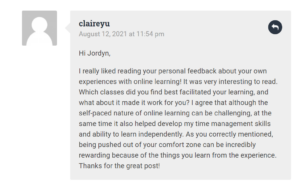
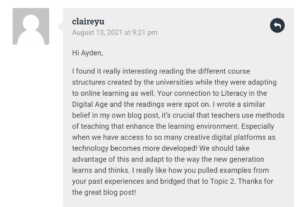
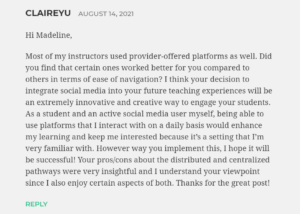
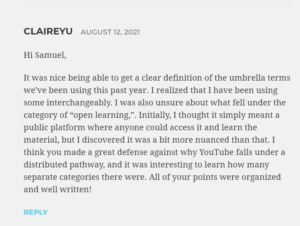
And I also received feedback from them:
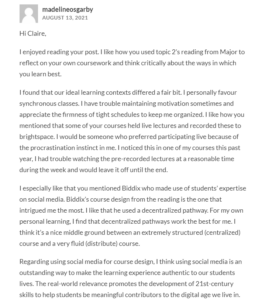
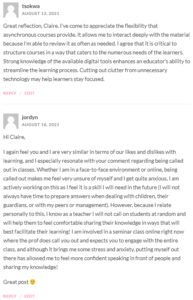
References:
Jordan, K. & Weller, M. (2017). Openness and Education: A beginners’ guide. Global OER Graduate Network.
3. Critically reflect on and articulate concepts around modality, pedagogy, and access, including distributed and open learning theory, online and open learning history, privacy laws, online learning communities, open research, and open data.
Topic 4 expanded my idea of opening learning from being more than just an online practice. I learned how diverse this definition is, and how we have been participating in it ourselves with EDCI 339. I enjoyed the format of this course because I was able to interact with the same 4 people throughout the semester, establishing close relationships and also getting detailed and informative feedback on the course content. I like that this medium was also visible publicly, so other classmates were besides my pod were able to view my posts, and vice versa.
Here is my Topic 4 discussion post:
https://tobiandcookie.opened.ca/topic-4-discussion-post/
I was also able to provide feedback on my pod members:
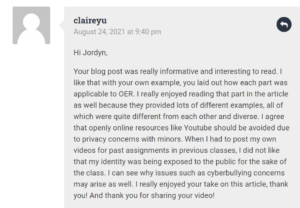
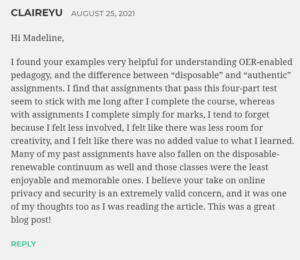
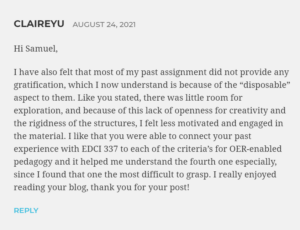
As I mentioned in the discussion post, for our reading on OER-enabled pedagogy and the 4 criteria suggested by the authors, “I think the test is a great way to help create a more engaging learning environment as well as provide opportunities for creativity.” I used my own example with an English class that was close to fulfilling the 4 criteria and my success with the assignments. I found that this particular system “helped me become more engaged in what I was learning mainly because I was taking “ownership” of my own topic of choice, I was expected to teach what I learned to other students, and there was also an element of creativity in each assignment that made it more fun.” My pod members also seemed to agree on the fact that most of their past assignments have been what we consider “disposable assignments”. In other words, these types assignments did not “stick” with me educationally and added no value to my learning outcome. The ones that I was involved with creating and sharing the most, or in other words, “renewable assignments,” were topics that I remembered so clearly afterwards that I was able to share what I learned with others after I completed the class.
4. Examine and reflect upon the potential for equitable access for all learners in online and open learning contexts.
The pod assignment challenged my group and I to examine some of the inequities that students may face in a learning environment. We created a persona who struggles with a diverse set of challenges to represent a variety of barriers to learning. In summary, our persona Johnny struggled with:
- Poor interpersonal skills, resulting in difficulties maintaining social connections
- A language barrier (his first language is French)
- Long commute from home to school, affecting his academic performance
- Ownership of electronic devices that support his learning (he had to share his devices with family members who use them frequently)
To support Johnny with these struggles, we came up with an asynchronous and distributed learning environment that allows him to work within pre-set time frames, supporting his busy schedule. Since he is in high school, we avoided an open environment to keep assignments and related school deliverables confidential. Johnny works with a case manager to help build his interpersonal skills and also attends an English Language Learner class to improve his English. He gets the chance to socialize and interact with others by meeting weekly with the Chess Club at school and tutoring younger students. Below, is a link to the full project posted on my teammate Samuel’s blog:
https://edci339powerpod.opened.ca/digital-equity-perspective-pod-project/
In addition to using Zoom for video calls, Jordyn, Madeline, Ayden, Samuel and myself interacted primarily on Facebook Messenger to discuss the details of this project:
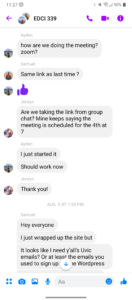
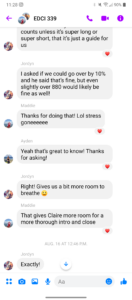
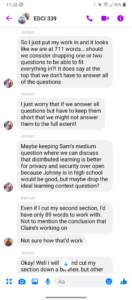
Then we migrated our work to Google Docs where we can add and edit our work together:
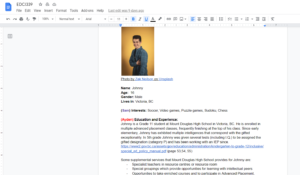
From completing these activities, I learned that an unequitable education system can create unfair learning disadvantages for a diverse pool of students. It’s important that these learning barriers are acknowledged and that schools will develop effective teaching strategies to decrease gaps in learning outcomes and create a more inclusive environment.
5. Conduct research into and critically reflect upon emerging and future educational technologies.
Topic 3’s reading on Design principles for Indigenous learning spaces encouraged me to do more research on future educational technologies that can remove learning disadvantages and reduce gaps in learning outcomes.
From doing these readings and additional research, I learned things I didn’t realize were important aspects in a learning environment. For example, spatial control effects how people can feel in a public environment. Feelings of discomfort and a sense of disempowerment and marginalization will prevent groups from comfortably accessing areas that facilitate learning, such as libraries, youth centers, media centers, public computers, etc. (Kral & Schwab, 2012). And these public spaces are so important because home literacy practice may be difficult for certain households, and these people rely on external resources to support their learning. In my Topic 3 comment section, my pod members discuss personal experiences related to these types of challenges:
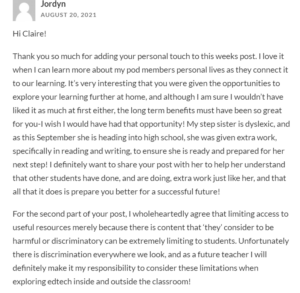
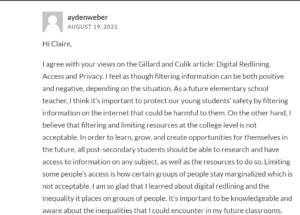
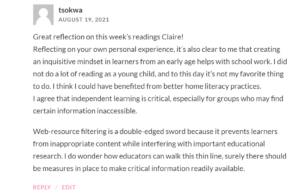
Reference:
Kral, I. & Schwab, R.G. (2012). Chapter 4: Design Principles for Indigenous Learning Spaces. Safe Learning Spaces. Youth, Literacy and New Media in Remote Indigenous Australia. ANU Press. http://doi.org/10.22459/LS.08.2012
6. Practice digital, networked, and open literacies in support of learning about distributed and open learning.
Similarly to learning outcome 5, The Topic 3 readings expanded on equity and accessibility in a learning environment, and we were able to fully see the learning barriers that a blatantly disadvantaged group like Indigenous peoples must face. As I state in my discussion post, “Like Kral and Schwab’s article discusses, it’s important that marginalized groups are provided with supportive resources where independent learning can be accessed. Not having access to digital technologies was one factor I have assumed would put an individual at a learning disadvantage, [but also] other aspects mentioned in the article, such as spatial control, play an extensive roles in our lives.” The full link to the post is below:
https://tobiandcookie.opened.ca/topic-3-discussion-post/
I was able to see the personal experiences of my pod members in their feedback on my post, and how the readings have inspired them to remove these inequities in their future teaching careers. I learned how they planned on improving distributed and open learning for their future students:
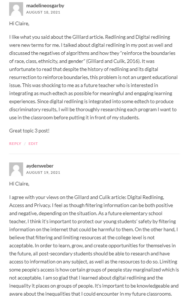
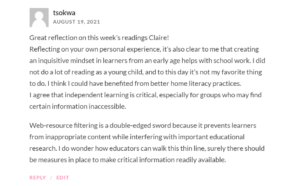
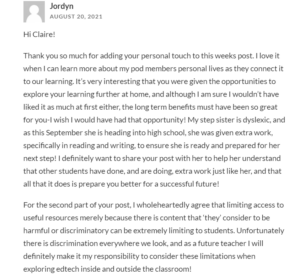
This learning contributed to my development of my practice of digital, networked, and open literacies in support of learning about distributed and open learning, because I was able to do more research on how schools and public areas can provide more supportive resources where independent learning can be accessed.
This learning matters to me because I believe everyone should feel safe in their learning environment. I believe that everyone should be given equal chances, and that any discriminatory biases in our education system should be removed.
Link to showcase blogpost: https://tobiandcookie.opened.ca/showcase-blogpost/
Leave a Reply